The Origins of Traditional Tales
Many of the well-known stories told to children, also known as fairy tales. These are stories that have been told to generations for centuries that feature fantastical and sometimes magical characters and environments.
There are so many wonderful benefits for children from reading traditional tales. They can teach them how to deal with real-life situations they may encounter, and enhance their creativity and imaginations.
With these stories going back so far they’ve been altered over the years, but it’s always interesting to see how they first started.
Keep reading to find out how some of children’s (and adults!) favourite traditional tales became what they are today.
Hansel and Gretel

Hansel and Gretel is a German fairy tale, most likely first created in the Middle Ages. Many believe that it may have been developed during the great famine of the 14th century that affected much of Europe at the time.
The best-known version is the one published by the Brothers Grimm in 1812. However, they did make changes to the story over the years and the final version was published in 1857. It’s also toned down as the early versions are much scarier for children!
Traditional tales are known to teach children about morality and right and wrong . One of the main lessons for children to take from Hansel and Gretel is not to trust strangers, regardless of how nice they appear to be. Also, as the popular version sees the siblings run away from home, it attempts to teach children to never wander too far from home.
Little Red Riding Hood

The story of Little Red Riding Hood is commonly known through the published versions by Charles Perrault and the Brothers Grimm. But the origins of this tale are said to go back as far as the 10th or 11th century. It’s believed it was told as a folktale by French peasants and the story then travelled by word of mouth to Italy where there are also several versions.
Similarly, to Hansel and Gretel, the moral of the story from Little Red Riding Hood is to be wary of strangers and treat anyone unknown to you with caution.
Jack and the Beanstalk

One of the oldest fairy tales is Jack and the Beanstalk. This Old English story actually goes back over 5000 years! The first written version was originally titled ‘Jack Spriggins and the Enchanted Bean‘ in 1734 by J. Roberts. The version by Joseph Jacobs published in his book English Fairy Tales in 1890 is the one commonly known today.
Jack and the Beanstalk has a big focus on good versus evil and being brave in difficult situations. One particular lesson it attempts to teach is to listen to your elders. If Jack had listened to his mother and exchanged the money for a cow rather than the magic beans he wouldn’t have gone through all that trouble with the giant!
Rapunzel

Rapunzel is a German fairy tale originating from an old oral tradition. Although there have been various versions, such as Friedrich Schultz’s in 1790, the most famous version is the Grimm’s Brothers from their 1812 anthology Children’s and Household Tales.
It’s been said that Rapunzel is loosely based on the true story of a woman known as Saint Barbara, during 3rd century Italy. Barbara was so beautiful that her father felt he had to lock her away in a tower to protect her.
Rapunzel is a love story, but also a caution tale for adults. It shows them that children will eventually grow up and they can’t shield them from the world and its harsh realities forever.
Goldilocks and the Three Bears

The earlier versions of Goldilocks were originally titled The Story of the Three Bears and the name Goldilocks wasn’t used until 1904. The first recorded edition was by Eleanor Mure in 1831, however there was no Goldilocks, instead an old woman invades the Bears’ house. Unfortunately for her she meets a much darker end!
The story, which is loved in the present comes from Robert Southey in 1837, but it was English writer Joseph Cundall who made the change from an old woman to the mischievous, golden-haired young girl we know today!
The moral of this tale is quite simple. It aims to teach children not to enter someone’s home or use their things without their permission. And to respect the property and privacy of others.
The Three Little Pigs

This English traditional tale was first published by James Halliwell-Phillips in The Nursery Rhymes of England in 1886. But of course, the story goes much further back than the 19th century. However, the original author is unknown.
The moral of the story is that hard work truly does pay off! The third pig decided to put in the time and effort to make his house sturdy which worked in his favour! It can teach your little ones to always take the time to do your work to the best of your ability.
Make sure to follow us on Instagram to discover some fun activities based on traditional tales.
Related blogs
Top Tips for Play with Rhyme Time
Author: Alice Sharp Alice is nationally and internationally recognised as using a dynamic and innovative approach to children. She uses an experiential approach in her role as early childhood influencer, keynote speaker, mum and writer. She is waiting to uplift...
Top Tips for Play with Gems, Jewels and Sparkles!
Author: Alice Sharp Alice is nationally and internationally recognised as using a dynamic and innovative approach to children. She uses an experiential approach in her role as early childhood influencer, keynote speaker, mum and writer. She is waiting to uplift...
Ollie’s top 10 tips for setting up a new nursery
Setting up a new nursery is an exciting opportunity to create a space where young children can thrive, explore, and grow. Whether you're opening a brand-new setting or refreshing an existing one, thoughtful planning is key. Our very own Ollie the Owl shares his top 10...


